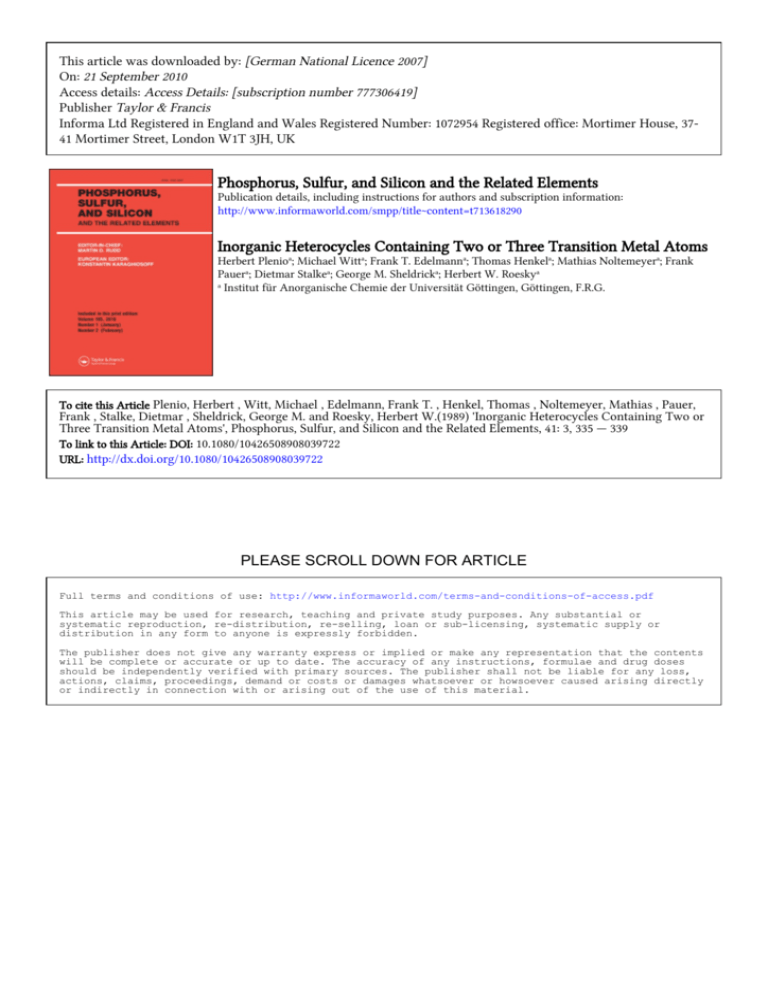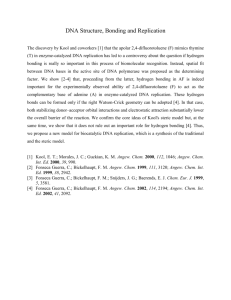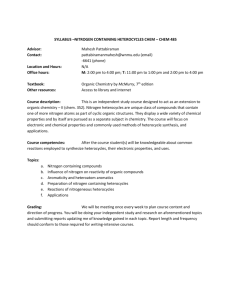Phosphorus, Sulfur, and Silicon and the Related
advertisement

This article was downloaded by: [German National Licence 2007] On: 21 September 2010 Access details: Access Details: [subscription number 777306419] Publisher Taylor & Francis Informa Ltd Registered in England and Wales Registered Number: 1072954 Registered office: Mortimer House, 3741 Mortimer Street, London W1T 3JH, UK Phosphorus, Sulfur, and Silicon and the Related Elements Publication details, including instructions for authors and subscription information: http://www.informaworld.com/smpp/title~content=t713618290 Inorganic Heterocycles Containing Two or Three Transition Metal Atoms Herbert Plenioa; Michael Witta; Frank T. Edelmanna; Thomas Henkela; Mathias Noltemeyera; Frank Pauera; Dietmar Stalkea; George M. Sheldricka; Herbert W. Roeskya a Institut für Anorganische Chemie der Universität Göttingen, Göttingen, F.R.G. To cite this Article Plenio, Herbert , Witt, Michael , Edelmann, Frank T. , Henkel, Thomas , Noltemeyer, Mathias , Pauer, Frank , Stalke, Dietmar , Sheldrick, George M. and Roesky, Herbert W.(1989) 'Inorganic Heterocycles Containing Two or Three Transition Metal Atoms', Phosphorus, Sulfur, and Silicon and the Related Elements, 41: 3, 335 — 339 To link to this Article: DOI: 10.1080/10426508908039722 URL: http://dx.doi.org/10.1080/10426508908039722 PLEASE SCROLL DOWN FOR ARTICLE Full terms and conditions of use: http://www.informaworld.com/terms-and-conditions-of-access.pdf This article may be used for research, teaching and private study purposes. Any substantial or systematic reproduction, re-distribution, re-selling, loan or sub-licensing, systematic supply or distribution in any form to anyone is expressly forbidden. The publisher does not give any warranty express or implied or make any representation that the contents will be complete or accurate or up to date. The accuracy of any instructions, formulae and drug doses should be independently verified with primary sources. The publisher shall not be liable for any loss, actions, claims, proceedings, demand or costs or damages whatsoever or howsoever caused arising directly or indirectly in connection with or arising out of the use of this material. 0 1989 Gordon Phosphorus, Suuur and Silica. Vol. 41, pp. 335-339 Reprints available directly from the publisher Photocopying permitted by license only and Breach, Science Publishers, Inc. Printed in the United Kingdom Downloaded By: [German National Licence 2007] At: 06:20 21 September 2010 INORGANIC HETEROCYCLES CONTAINING TWO OR THREE TRANSITION METAL ATOMS HERBERT PLENIO, MICHAEL WITT, FRANK T.EDELMANN, THOMAS HENKEL, MATHIAS NOLTEMEYER, FRANK P A U E R , DIETMAR STALKE, GEORGE M. SHELDRICK AND HERBERT w. ROESKY* Institut fiir Anorganische Chemie der Universitat Gijttingen, Tammannstr. 4, D-3400 Gijttingen, F.R.G. Abstract Syntheses and structures o f novel inorganic heterocycles containing two or three transition metal atoms are reported. Examples include the first triazatrimetallabenzene derivative, [Cp*Ta(Cl)N] 3 , as well as eightmembered phosphazene rings containing two vanadium atoms. INTRODUCTION The chemistry o f unsaturated inorganic heterocyles is of current interest. Recently we have developed general . synthetic routes to c y c l o m e t a l l a p h o s p h a z e n e s 1 - 3 Typical examples are the six-membered heterocycles 1 - and -2 , in which a phosphorus atom o f the phosphazene ring is replaced by a transition metal atom: H .. Xn Xn 335 PS - D 336 H.W.ROESKY et al. RESULTS AND DISCUSSION Four-membered titanaheterocycles are formed in the re- - with action of the silylated amino-iminophosphorane 2 4 Two cyclic products, orange yellow 4- and pale TiC14 . Downloaded By: [German National Licence 2007] At: 06:20 21 September 2010 yellow 5. - are isolated in moderate yield by fractional crystallization from acetonitrile: /N S iMe Ph P‘N(SiMe3l2 + TiC14 - SiMe3 (CH3CN)C1 Ti/N\ \N/ 4 - PPh2 SiMe3 + S iMe I /N\C1 Ph2P\ / Ti fCH3CN) \N N\ / \ (CH3CN)Ti C$/pph2 N -5 I SiMe 3 The molecular structures of 4- and -5 were determined by X-ray crystallography. Nitrido complexes of the early transition metals form a variety o f different structures5. Monomers and dimers are known as well a s tri- and tetranuclear complexes and linear polymers. We describe here the preparation of the first cyclic trimer of a metal nitride. Cp*TaC14 reacts with N(SnMe3)3 room temperature 6 7 % yield:6 t o in toluene solution at give the yellow metallacycle 6 in HETEROCYCLES CONTAINING TRANSITION METALS 337 This very stable compound can be sublimed at ca. 25OoC under high vacuum. The mass spectrum shows the molecular ion and the IH-NMR data (singlets at 6 2.09 and 2.13 ppm) indicate that the molecule contains non- * equivalent Cp ligands. An X-ray structure determination clearly shows the presence of the first triaza- Downloaded By: [German National Licence 2007] At: 06:20 21 September 2010 tritantalabenzene derivative: The six-membered T a N ring is not exactly planar but 3 3 slightly distorted towards a boat conformation. The average tantalum-nitrogen bond length i s 188(2) pm. This value lies right between those found for Ta=NR (174-178 pm) and Ta-NR2 (195-203 pm). It is interest- ing to note that a cyclic trimer of a metal nitrido complex had already been postulated by Hoffmann et al. in 1 9 8 6 7 . Two eight-membered ring systems have recently been discovered using different synthetic routes. Treatment o f CpCp*ZrCl with Me SnNSNSnMe gives a n un2 3 3 saturated eight-membered metallacycle 1 with two 8 zirconium atoms in the ring : 2CpCp*ZrCI2 + 2 Me,SnNSNSnMe, - - 4 Me,SnCl / NSN , CpCp*Zr zrcpcp* 'NSN / 338 H.W.ROESKY et al. The yellow complex 1 - is isolated in 6 5 % yield and the by-product Me SnCl is easily removed by sublimation. 3 The corresponding hafnium derivative - is obtained in an analogous manner. IH-NMR spectra of 1 - and - exhibit two sets of signals for the Cp and Cp’ligands in a ratio of approximately 1 : 2 . This can be explained by the existence of two isomers. It can be assumed that Downloaded By: [German National Licence 2007] At: 06:20 21 September 2010 isomer B is favored for steric reasons: CPt Zr -( NSN l2 CP / - Zr / CP* cp\ Zr \ CP - ( NSN )2- / CP* \ CP Zr cp*/ B A Silylated iminophosphoranes were used as starting materials for the synthesis of the first eight-membered cyclometallaphosphazene ring system 9 ’ 1 0 , Treatment of VOCl in aceto3 nitrile solution results in the formation of dark red, crystalline 3 2- with Ph2P[N(SiMe3)2]NSiMe in 80% yield. This material is formed by elimination of four equivalents of M e Sic1 and 3 migration of trimethylsilyl groups to the oxygen atoms: Ph N SiMeJ \ / 2 P Ph’ ‘N(SiMe,), ? Me3SiOV-N =PPh, + 2V0CI3 - I II NI ‘+ P h N It ‘N-VOSiMe3 I --9 + 4 MejSiCl CI An X-ray analysis demonstrates that the ring system is exactly planar. The two vanadium atoms are tetrahedrally coordinated. The V-N distances (ave. 1 6 7 . 0 ( 5 ) ) are similar to those found in vanadium nitrene complexes. Using Ph2P(NSiMe 3 )C1 and Me3SiNVC13 as starting materials the tetrachloro derivative of the new ring system was synthesized in high yield: HETEROCYCLES CONTAINING TRANSITION METALS 339 Downloaded By: [German National Licence 2007] At: 06:20 21 September 2010 ACKNOWLEDGEMENTS The authors thank the Deutsche Forschungsgemeinschaft, the Fonds der Chemischen Industrie and the VolkswagenStiftung for their generous support of this work. REFERENCES 1. H. w. Roesky, K. V. Katti, U. Seseke, M. w i t t y E. Egert, R. Herbst and G. M. Sheldrick, Angew. Chem. 9 8 , 4 4 7 ( 1 9 8 6 ) , Angew. Chem. Int. Ed. Engl. 25, 2. 3. 4. 5. 6. 7. 8. 9. 10. 477(1986). H. W. Roesky, K. V. Katti, U. Seseke, H. G. Schmidt, E. Egert, R. Herbst and G . M. Sheldrick, J. Chem. SOC. Dalton Trans. 1 9 8 7 , 8 4 7 . K. V. Katti, H. W. Roesky and M. Rietzel, Inorg. Chem. - -2 6 , 8 1 4 ( 1 9 8 7 ) . M. Witt, H. W. Roesky, D. Stalke, F. Pauer, T. Henkel and G . M. Sheldrick, J. Chem. SOC. Dalton Trans., in press. K. Dehnicke and J. Strahle, Angew. Chem. 9 3 , 4 5 1 ( 1 9 8 1 ) , Angew. Chem. Int. Ed. Engl. 2 0 , 4 1 3 ( 1 9 8 1 ) . H. Plenio, H. W. Roesky, M. N o l t e m e y z and G. M. Sheldrick, Angew. Chem., in press. R. A. Wheeler, R. Hoffmann and J. Strahle, J. Am. Chem. SOC. 1 0 8 , 5 3 8 1 ( 1 9 8 6 ) . H. Plenio and H. W. Roesky, 2 . Naturforsch., in press. M. Witt, H. W. Roesky, M. Noltemeyer and G. M. Sheldrick, Angew. Chem. 100, 8 5 2 ( 1 9 8 8 ) , Angew. Chem. Int. Ed. Engl. 2 7 , 8 5 0 ( 1 9 8 8 ) . M. Witt and H. W. Roesky, unpublished results.





